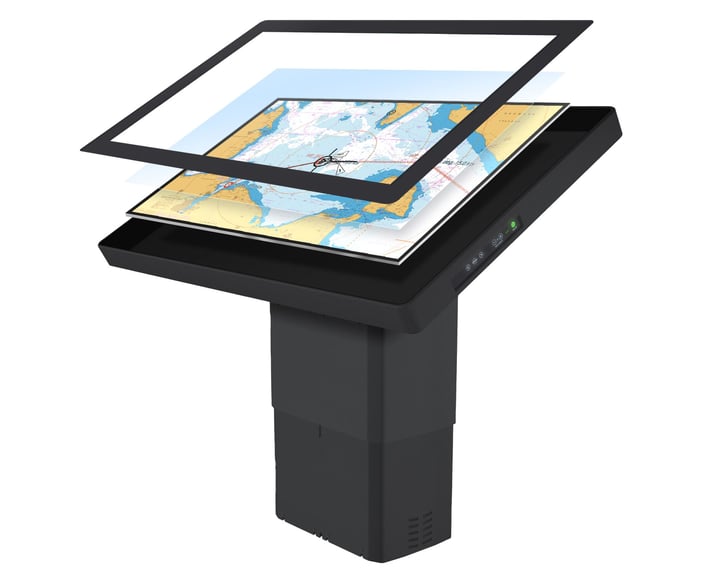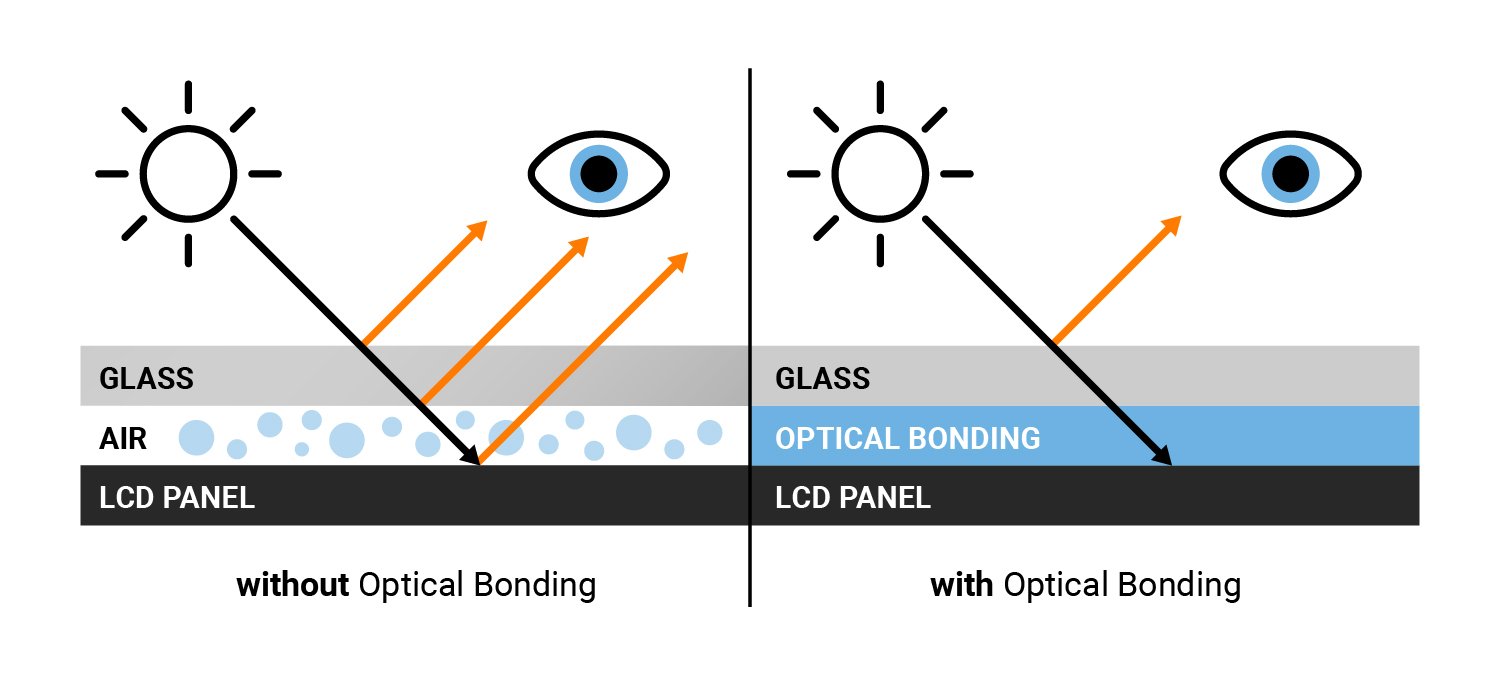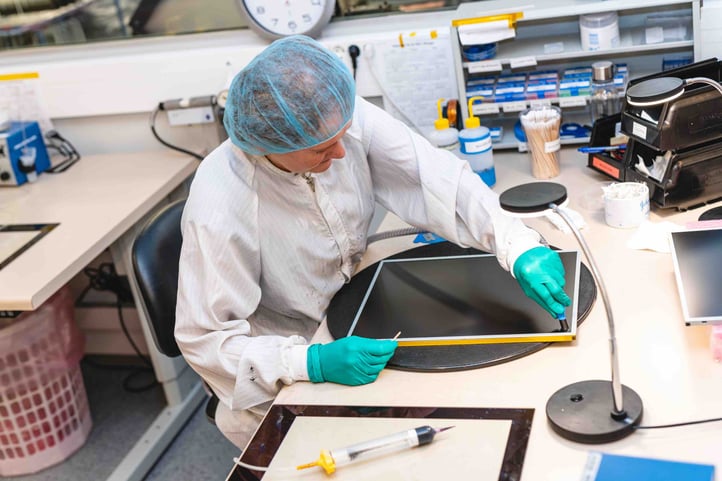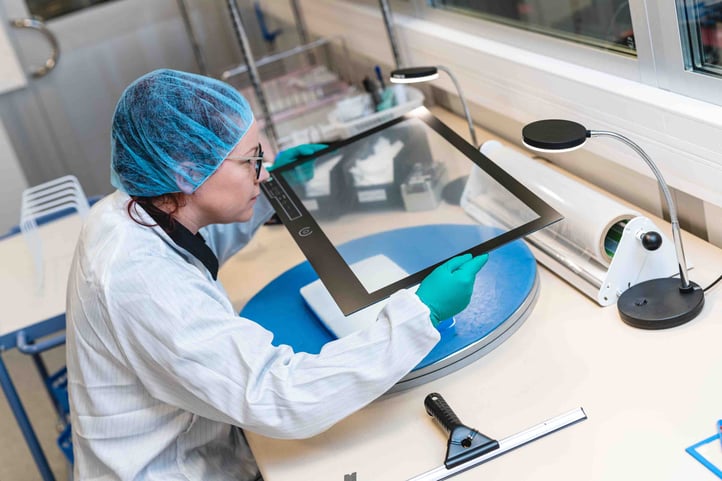
Let's take a closer look at optical bonding
The arguably greatest addition to any industrial display is one you can’t see. In fact, that’s the whole point.
Industrial IT hardware must cope with a variety of challenges. Designing top-drawer devices requires you to pair technical finesse with physical robustness, which means solving for several variables, simultaneously.
For an industrial display, the perhaps most consequential variable is light; both the light it emits and the light it reflects. That is why many professional users consider optical bonding a must.
Optical bonding:
- Reduces glare.
- Protects against particle contamination.
- Prevents condensation (the display won’t fog up).
- Increases vibration- and shock endurance.
In short, it makes monitors look better, perform better, and last longer.
Want to know more? Join us and learn the basics from optoelectronics engineer and Vice President R&D at Hatteland Technology, Mr. Jakub Kwiatkowski.
What is optical bonding, and why do you need it?
– Have you ever tried taking your laptop outside on a sunny day, hoping to get some work done? That’s what it’s often like on a ship bridge, Kwiatkowski says. —Optical bonding is the art of eliminating reflections from displays.
He says consumer products, such as laptops or TVs, don’t require the same anti-reflective capabilities as their industrial cousins. But for many professional users — say, the navigation officer on a ship – the treatment is essential.
– If you’re navigating through a busy shipping lane, you’ll want to have readable monitors. Everyone in your vicinity would want you to have them, too, he chuckles.

A must for bright environments:
Optical bonding is a must for any monitor intended for the ship’s bridge, where a generous flux of sunlight is to be expected. The HT HD55 electronic chart table is a case in point.
Mr. Kwiatkowski has designed industrial displays for more than 15 years and has an intimate understanding of how optical bonding does away with glare. Having studied display behavior in almost every conceivable scenario, he says the extra effort is exceedingly worthwhile.
– Optical bonding is a staple of high-performance industrial monitors, he says and directs our attention to an illustration he has prepared.
Understanding why reflection occurs
An ordinary display is seen to reflect light both externally and internally. “That’s what you don’t want”, he asserts and looks every bit as serious as he sounds. Next to it, an alternative configuration is seen to get rid of almost all reflections of the oncoming light. It’s an optically bonded display, combined with a high-quality, anti-reflective coating.
With the latter, you see what you intend to see (and little else).

Above: Air-gapped displays are far more reflective than their optically bonded equivalents,
as the latter remove most of the specular surfaces, significantly reducing glare.
LCD (liquid crystal display) monitors use a polarizer material. The material is fragile, so manufacturers protect the LCD surface with a glass or plastic window. When the protective window is placed in front of the LCD, an air gap is formed between the front polarizer and the cover window.
This air gap (regardless of the thickness) causes optical conditions which increase reflection, thus reducing display contrast and clear perception of colours.
– The protective window safeguards the LCD polarizer, but reduces display viewability, Mr. Kwiatkowski explains. – Which means, by protecting the display, you also compromise its performance.
That sounds problematic, and it is. But there is a remedy available. The engineer promises to reveal the solution soon, but first wants to educate us a bit more.

We learn how the reduced viewability happens because the air gap leads to the presence of different refractive indices, obstructing the transmitted light. This causes “image washout”, a condition that occurs when the reflected light is too intense relative to the emitted light from the display image.
For these reasons, air-gapped LCD products are not considered sunlight-viewable. And because many industrial users need their monitors to perform in all kinds of scenarios, outdoors even, that problem brings us to the next question.
What can you do about it?
The solution looks magical (but it’s just physics)
–There are a couple of ways you can deal with glare. One is better than the others, Mr. Kwiatkowski says.
– For an ok result, you can use anti-reflective (AR) coatings on the front- and back surfaces of the cover glass, and even on the surface of the front polarizer. That will minimize reflection levels. But even multiple layers of AR coating won’t remove the air gap, which means reflection can still occur on all the display’s surfaces. If you’re dealing with sunlight, combining AR coating and optical bonding is the only viable option, he asserts.

Above and below: Optical bonding in Hatteland Technology’s manufacturing facilities in Aksdal, Norway.

Let's dig a bit deeper.
The ultimate remedy against reflections is to eliminate all the specular surfaces between the display polarizer and the display cover glass. Put simply: One must eliminate the air gap.
This is done by applying a resin which “optically bonds” to the glass and the polarizer surfaces, displacing and eliminating all the air. The result is a stack of materials which allows for uniform light transmission, and much reduced reflections. If you combine it with an AR-coated front surface, the results will be fantastic.
– With optical bonding, you maintain the contrast ratio and eliminate reflection “washout”, Kwiatkowski says.
These are key elements for making a monitor sunlight readable. That’s the most important thing, but it’s not the only benefit you get from optical bonding. Eliminating the air gap also eliminates the risk of particle contamination, condensation, or fogging.
– Condensation can be a major disturbance for users, he says. – Especially in maritime- or naval scenarios.

Above: This is how happy Mr. Jakub Kwiatkowski becomes
when he gets to talk about optical bonding.
By bonding the display you also eliminate the possibility of particles developing between the display and cover glass. Furthermore, it makes the monitor's structure much more stable mechanically, increasing its tolerance for vibration and shock.
There’s a safety dimension, too: The bonded display cover glass effectively turns into laminated safety glass. Which means in case the cover glass ever breaks, the optical material will help protect the user by holding the broken cover glass pieces together.
– Even if the front gets damaged, you’ll likely be able to use the display. That alone could prove valuable in a high-pressure situation, he concludes.
Related material:
Color calibration for ECDIS: What it is and why it matters
This electronic chart table brings the bridge into the digital era
What Furuno Norway looks for in a supplier
Your solution partner: How Hatteland Technology can help you
